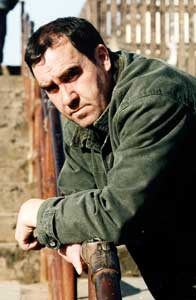31 August 2006 Edition
Gas attack : Ex-POW calls on British to come clean

Jim McCann was a sentenced republican prisoner at the time of the burning of Long Kesh
Gas 10 times stronger than CS used on Long Kesh prisoners
BY
PEADAR O FAOLAIN
"CR gas, for the uninitiated, is manufactured in hell. The fires of hell create this stuff and the Devil sells it under licence to the British Government. They in turn, after carrying out tests on their most implacable of enemies, the Irish, sell it to the despots, dictators and democracies of the world."
This was Jim McCann, a republican former POW from West Belfast, writing about the effects of CR Gas in his 1998 book, And the Gates Flew Open.
McCann was recounting the events in October 1974 when republican prisoners held in the Cages of Long Kesh rebelled against the prison regime and torched the camp, used to hold sentenced republican prisoners as well as internees held without trial.
On the evening of 16 October, the prisoners, reacting to the continued attempts by the prison authorities to break them, set fire to their accommodation huts, offices used by prison guards and observation posts as they razed the entire camp to the ground.
In the ensuing riots, which continued over two days, the POWs fought pitched battles with frontline British Army regiments, including the Parachute Regiment and Royal Marines.
The main fighting took place at the football pitches, which were located near the centre of the camp. The British soldiers were armed with CS gas and rubber-bullet guns, but despite firing copious amounts of gas and rubber bullets they were unable to break the resistance of the courageous, well-organised and disciplined republicans.
However, it was the following day that the real story of the events of 16 and 17 October emerged.
Given their inability to quell the prison uprising using their more conventional weapons, the British Government resorted to the use of the highly carcinogenic CR gas.
Developed in the 1960s as a counter-insurgency weapon, CR gas is now stockpiled in Porton Down, the British Ministry of Defence's biological warfare facility.
It was also discovered that the British Government offered the new weapon to the Pentagon but they refused it, stating:
"Not enough is known about the carcinogenic or mutagenic effects it might have."
All supplies of the weapons were recalled for storage to Porton Down in 1977, raising fears about the effects of CR gas on humans.
To this day, successive British governments have denied that the substance was used in the Long Kesh riots in 1974.
Indeed, on 11 January 1999, in a written response to a question from Labour MP Ken Livingstone, Labour's then Minister for the Armed Forces, John Spellar, replied:
"The British Army has never used CR gas operationally."
It has been established, however, in documents obtained through the Freedom of Information Act, that CR gas was supplied to the British military guards posted at Long Kesh.
Journalists Craig Morrison and Martin Bright wrote in Britain's The Observer newspaper in 2005:
"The British Government secretly authorised the use of a chemical riot control agent... to be used in prisons at the height of the Northern Ireland Troubles."
The article went on to say:
"CR gas was permitted from 1973 to be used on prison inmates in the event of an attempted mass break-out."
Jim McCann was a sentenced republican prisoner at the time of the burning of Long Kesh.
He is convinced, despite the denials of successive British governments, that CR gas was used to subdue the rioting prisoners in 1974.
McCann described how, after a night of heavy fighting, the prisoners had formed up on the football pitches and faced the British Army.
The prisoners were gearing themselves up for the next onslaught by the soldiers when helicopters flew over the prisoners and dropped the CR gas into their midst.
The gas was fired in clusters which scattered in mid-air and spread the gas over a wider area to make it more effective.
The former POW remembered how the gas affected him:
"I thought they were using flame-throwers and that I was on fire."
Others describe feeling a drowning sensation when they were overcome by the gas.
A Swiss-based professor of chemistry, whom McCann consulted, compared CR and CS gas and found that CR gas was 10 times more potent than CS gas.
According to McCann:
"This man isn't surprised CR gas is held in Porton Down."
McCann also believes that the British Ministry of Defence authorised the use of CR gas on the rioting prisoners as a field test for the new weapon.
He has uncovered a British Government operation codenamed 'Snowdrop' which involved the SAS dealing with hi-jackings or ending sieges.
Speaking to An Phoblacht, McCann said Snowdrop was highly secretive at the time.
He says that in documents he has uncovered through the Freedom of Information Act, Snowdrop is described as "the contingency plan developed to deal with hi-jacking and other serious armed terrorist incidents, in particular those which involve the taking of hostages, be they human or material".
The plan provides for a counter-terrorist force of 16 men from 22 SAS who have a wide range of equipment, including swift motor transport, radio communications, night vision devices, sniper rifles, close combat weapons and CR devices.
"The riot in Long Kesh was a golden opportunity for the British Government to test this weapon."
He is also convinced that the British Government is covering up the harm the gas has done to those prisoners affected by it.
"More than 50 men, including many who led healthy lifestyles, have since died or are suffering from cancer. These cancers may or not have been caused by CR gas but it is up to the British Government to come clean about the events of Long Kesh in October 1974."



